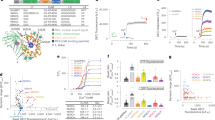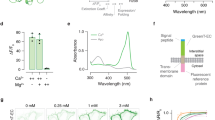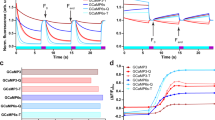Abstract
The jellyfish Aequorea victoria produces a 22-kDa protein named aequorin that has had an important role in the study of calcium (Ca2+) signaling. Aequorin reacts with Ca2+ via oxidation of the prosthetic group, coelenterazine, which results in emission of light. This signal can be detected by using a special luminescence reader (called aequorinometer) or luminescence plate readers. Here we describe the main characteristics of aequorin as a Ca2+ probe and how to measure Ca2+ in different intracellular compartments of animal cells (cytosol, different mitochondrial districts, nucleus, endoplasmic reticulum (ER), Golgi apparatus, peroxisomes and subplasma-membrane cytosol), ranging from single-well analyses to high-throughput screening by transfecting animal cells using DNA vectors carrying recombinant aequorin chimeras. The use of aequorin mutants and modified versions of coelenterazione increases the range of calcium concentrations that can be recorded. Cell culture and transfection takes ∼3 d. An experiment including signal calibration and the subsequent analyses will take ∼1 d.
This is a preview of subscription content, access via your institution
Access options
Subscribe to this journal
Receive 12 print issues and online access
$259.00 per year
only $21.58 per issue
Buy this article
- Purchase on Springer Link
- Instant access to full article PDF
Prices may be subject to local taxes which are calculated during checkout




Similar content being viewed by others
References
Clapham, D.E. Calcium signaling. Cell 131, 1047–1058 (2007).
Berridge, M.J., Bootman, M.D. & Roderick, H.L. Calcium signalling: dynamics, homeostasis and remodelling. Nat. Rev. Mol. Cell Biol. 4, 517–529 (2003).
Rizzuto, R. & Pozzan, T. When calcium goes wrong: genetic alterations of a ubiquitous signaling route. Nat. Genet. 34, 135–141 (2003).
Pinton, P. et al. Reduced loading of intracellular Ca2+ stores and downregulation of capacitative Ca2+ influx in Bcl-2-overexpressing cells. J. Cell Biol. 148, 857–862 (2000).
Marchi, S. et al. Downregulation of the mitochondrial calcium uniporter by cancer-related miR-25. Curr. Biol. 23, 58–63 (2013).
Shimomura, O., Johnson, F.H. & Saiga, Y. Extraction, purification and properties of aequorin, a bioluminescent protein from the luminous hydromedusan, Aequorea. J. Cell Comp. Physiol. 59, 223–239 (1962).
Shimomura, O. Isolation and properties of various molecular forms of aequorin. Biochem. J. 234, 271–277 (1986).
Johnsn, F.H. & Shimomura, O. Preparation and use of aequorin for rapid microdetermination of Ca2+ in biological systems. Nat. New Biol. 237, 287–288 (1972).
Allen, D.G. & Blinks, J.R. Calcium transients in aequorin-injected frog cardiac muscle. Nature 273, 509–513 (1978).
Robert, V., Pinton, P., Tosello, V., Rizzuto, R. & Pozzan, T. Recombinant aequorin as tool for monitoring calcium concentration in subcellular compartments. Methods Enzymol. 327, 440–456 (2000).
Chiesa, A. et al. Recombinant aequorin and green fluorescent protein as valuable tools in the study of cell signalling. Biochem. J. 355, 1–12 (2001).
Shimomura, O., Musicki, B., Kishi, Y. & Inouye, S. Light-emitting properties of recombinant semi-synthetic aequorins and recombinant fluorescein-conjugated aequorin for measuring cellular calcium. Cell Calcium 14, 373–378 (1993).
Kendall, J.M., Sala-Newby, G., Ghalaut, V., Dormer, R.L. & Campbell, A.K. Engineering the Ca2+-activated photoprotein aequorin with reduced affinity for calcium. Biochem. Biophys. Res. Commun. 187, 1091–1097 (1992).
de la Fuente, S., Fonteriz, R.I., de la Cruz, P.J., Montero, M. & Alvarez, J. Mitochondrial free [Ca2+] dynamics measured with a novel low-Ca2+ affinity aequorin probe. Biochem. J. 445, 371–376 (2012).
Brini, M. et al. Transfected aequorin in the measurement of cytosolic Ca2+ concentration ([Ca2+]c). A critical evaluation. J. Biol. Chem. 270, 9896–9903 (1995).
Sorrentino, G. et al. The prolyl-isomerase Pin1 activates the mitochondrial death program of p53. Cell Death Differ. 20, 198–208 (2013).
Lasorsa, F.M. et al. Peroxisomes as novel players in cell calcium homeostasis. J. Biol. Chem. 283, 15300–15308 (2008).
Pinton, P., Pozzan, T. & Rizzuto, R. The Golgi apparatus is an inositol 1,4,5-trisphosphate-sensitive Ca2+ store, with functional properties distinct from those of the endoplasmic reticulum. EMBO J. 17, 5298–5308 (1998).
Barrero, M.J., Montero, M. & Alvarez, J. Dynamics of [Ca2+] in the endoplasmic reticulum and cytoplasm of intact HeLa cells. A comparative study. J. Biol. Chem. 272, 27694–27699 (1997).
Alonso, M.T., Chamero, P., Villalobos, C. & Garcia-Sancho, J. Fura-2 antagonises calcium-induced calcium release. Cell Calcium 33, 27–35 (2003).
Schoenmakers, T.J., Visser, G.J., Flik, G. & Theuvenet, A.P. CHELATOR: an improved method for computing metal ion concentrations in physiological solutions. Biotechniques 12, 870–874, 876–879 (1992).
Markova, S.V. et al. The light-sensitive photoprotein berovin from the bioluminescent ctenophore Beroe abyssicola: a novel type of Ca2+ -regulated photoprotein. FEBS J. 279, 856–870 (2012).
Markova, S.V. et al. Obelin from the bioluminescent marine hydroid Obelia geniculata: cloning, expression, and comparison of some properties with those of other Ca2+-regulated photoproteins. Biochemistry 41, 2227–2236 (2002).
Miyawaki, A., Griesbeck, O., Heim, R. & Tsien, R.Y. Dynamic and quantitative Ca2+ measurements using improved cameleons. Proc. Natl. Acad. Sci. USA 96, 2135–2140 (1999).
Garaschuk, O., Griesbeck, O. & Konnerth, A. Troponin C-based biosensors: a new family of genetically encoded indicators for in vivo calcium imaging in the nervous system. Cell Calcium 42, 351–361 (2007).
Griesbeck, O., Baird, G.S., Campbell, R.E., Zacharias, D.A. & Tsien, R.Y. Reducing the environmental sensitivity of yellow fluorescent protein. Mechanism and applications. J. Biol. Chem. 276, 29188–29194 (2001).
Nagai, T., Sawano, A., Park, E.S. & Miyawaki, A. Circularly permuted green fluorescent proteins engineered to sense Ca2+. Proc. Natl. Acad. Sci. USA 98, 3197–3202 (2001).
Zhao, Y. et al. An expanded palette of genetically encoded Ca2+ indicators. Science 333, 1888–1891 (2011).
Thomas, D. et al. A comparison of fluorescent Ca2+ indicator properties and their use in measuring elementary and global Ca2+ signals. Cell Calcium 28, 213–223 (2000).
Blatter, L.A. & Wier, W.G. Intracellular diffusion, binding, and compartmentalization of the fluorescent calcium indicators indo-1 and fura-2. Biophys. J. 58, 1491–1499 (1990).
Brini, M. et al. Nuclear Ca2+ concentration measured with specifically targeted recombinant aequorin. EMBO J. 12, 4813–4819 (1993).
Rizzuto, R., Simpson, A.W., Brini, M. & Pozzan, T. Rapid changes of mitochondrial Ca2+ revealed by specifically targeted recombinant aequorin. Nature 358, 325–327 (1992).
Montero, M. et al. Chromaffin-cell stimulation triggers fast millimolar mitochondrial Ca2+ transients that modulate secretion. Nat. Cell Biol. 2, 57–61 (2000).
Rizzuto, R. et al. Close contacts with the endoplasmic reticulum as determinants of mitochondrial Ca2+ responses. Science 280, 1763–1766 (1998).
Marsault, R., Murgia, M., Pozzan, T. & Rizzuto, R. Domains of high Ca2+ beneath the plasma membrane of living A7r5 cells. EMBO J. 16, 1575–1581 (1997).
Montero, M. et al. Monitoring dynamic changes in free Ca2+ concentration in the endoplasmic reticulum of intact cells. EMBO J. 14, 5467–5475 (1995).
Brini, M. et al. Subcellular analysis of Ca2+ homeostasis in primary cultures of skeletal muscle myotubes. Mol. Biol. Cell 8, 129–143 (1997).
Mitchell, K.J. et al. Dense core secretory vesicles revealed as a dynamic Ca2+ store in neuroendocrine cells with a vesicle-associated membrane protein aequorin chimaera. J. Cell Biol. 155, 41–51 (2001).
Ashworth, R. & Brennan, C. Use of transgenic zebrafish reporter lines to study calcium signalling in development. Brief Funct. Genomic Proteomic. 4, 186–193 (2005).
Ainscow, E.K. & Rutter, G.A. Mitochondrial priming modifies Ca2+ oscillations and insulin secretion in pancreatic islets. Biochem. J. 353, 175–180 (2001).
Alonso, M.T. et al. Functional measurements of [Ca2+] in the endoplasmic reticulum using a herpes virus to deliver targeted aequorin. Cell Calcium 24, 87–96 (1998).
Rembold, C.M., Kendall, J.M. & Campbell, A.K. Measurement of changes in sarcoplasmic reticulum [Ca2+] in rat tail artery with targeted apoaequorin delivered by an adenoviral vector. Cell Calcium 21, 69–79 (1997).
Le Poul, E. et al. Adaptation of aequorin functional assay to high-throughput screening. J. Biomol. Screen. 7, 57–65 (2002).
Menon, V. et al. Development of an aequorin luminescence calcium assay for high-throughput screening using a plate reader, the LumiLux. Assay Drug Dev. Technol. 6, 787–793 (2008).
Giorgi, C. et al. Translocation of signalling proteins to the plasma membrane revealed by a new bioluminescent procedure. BMC Cell Biol. 12, 27 (2011).
Cobbold, P.H., Cuthbertson, K.S., Goyns, M.H. & Rice, V. Aequorin measurements of free calcium in single mammalian cells. J. Cell Sci. 61, 123–136 (1983).
Creton, R., Steele, M.E. & Jaffe, L.F. Expression of apo-aequorin during embryonic development; how much is needed for calcium imaging? Cell Calcium 22, 439–446 (1997).
Webb, S.E., Rogers, K.L., Karplus, E. & Miller, A.L. The use of aequorins to record and visualize Ca2+ dynamics: from subcellular microdomains to whole organisms. Methods Cell Biol. 99, 263–300 (2010).
Torrecilla, I., Leganes, F., Bonilla, I. & Fernandez-Pinas, F. Use of recombinant aequorin to study calcium homeostasis and monitor calcium transients in response to heat and cold shock in cyanobacteria. Plant Physiol. 123, 161–176 (2000).
Acknowledgements
This research was supported by the Italian Association for Cancer Research (AIRC), Telethon (GGP11139B), local funds from the University of Ferrara, the Italian Ministry of Education, University and Research (COFIN, FIRB and Futuro in Ricerca) and Italian Ministry of Health to P.P.; by Italian Ministry of Health to A.R.; by AIRC to C.G.; by grants from the Italian Ministries of Health and of Education, University and Research, the European Union (ERC mitoCalcium, no. 294777 and FP7 'MyoAGE', no. 223576), US National Institutes of Health (grant no. 2P01AG025532-06A1), Cariparo Foundation (Padua), Cariplo (no. 2012-06-46), AIRC and Telethon-Italy (GPP1005A, GGP11082) to R.R. S.M. was supported by a FIRC fellowship. S.P. was supported by a research fellowship FISM (Cod. 2012/B/11).
Author information
Authors and Affiliations
Contributions
All authors contributed extensively to the work presented in this paper. M.B., C.G., A.B., S.M. and A.R. performed experiments; M.B., C.G., A.B., S.M., A.R., R.R. and P.P. analyzed data; and M.B., C.G. and P.P. wrote the paper.
Corresponding author
Ethics declarations
Competing interests
The authors declare no competing financial interests.
Rights and permissions
About this article
Cite this article
Bonora, M., Giorgi, C., Bononi, A. et al. Subcellular calcium measurements in mammalian cells using jellyfish photoprotein aequorin-based probes. Nat Protoc 8, 2105–2118 (2013). https://doi.org/10.1038/nprot.2013.127
Published:
Issue Date:
DOI: https://doi.org/10.1038/nprot.2013.127
This article is cited by
-
Unusual shift in the visible absorption spectrum of an active ctenophore photoprotein elucidated by time-dependent density functional theory
Photochemical & Photobiological Sciences (2021)
-
Defective endoplasmic reticulum-mitochondria contacts and bioenergetics in SEPN1-related myopathy
Cell Death & Differentiation (2021)
-
Regulation of [Ca2+]i oscillations and mitochondrial activity by various calcium transporters in mouse oocytes
Reproductive Biology and Endocrinology (2020)
-
Susceptibility to cellular stress in PS1 mutant N2a cells is associated with mitochondrial defects and altered calcium homeostasis
Scientific Reports (2020)
-
Discovery of EMRE in fungi resolves the true evolutionary history of the mitochondrial calcium uniporter
Nature Communications (2020)
Comments
By submitting a comment you agree to abide by our Terms and Community Guidelines. If you find something abusive or that does not comply with our terms or guidelines please flag it as inappropriate.



